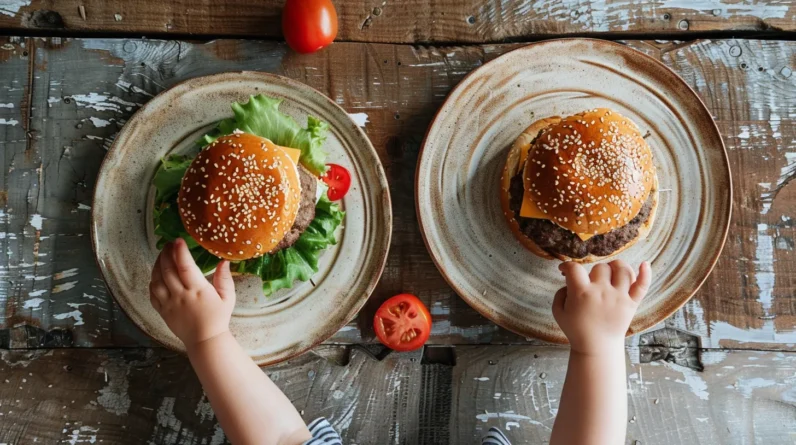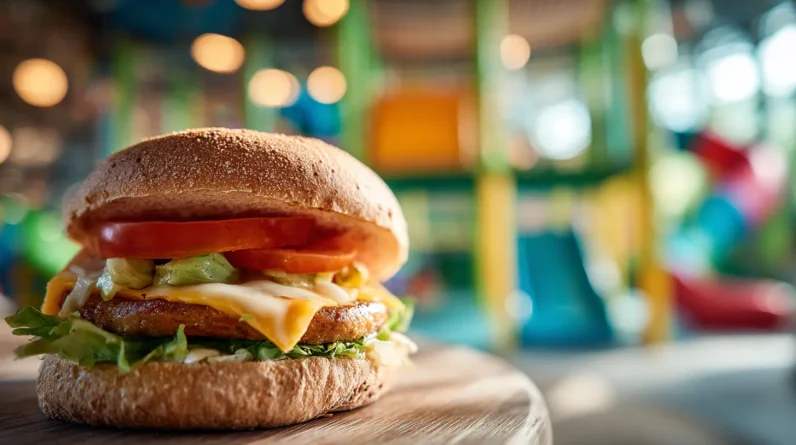
Kids often reject veggie burgers due to natural food neophobia, a protective instinct that peaks between ages 2-6, combined with their heightened taste sensitivity and strong social influences. We’ve found that children have more taste buds than adults, making them especially aware of differences between plant-based and traditional meat burgers. The key to changing this lies in gradual exposure, positive modeling, and strategic presentation. Getting kids involved in meal prep can increase acceptance by 5 times, while fun presentations and familiar toppings help bridge the gap. Let’s explore proven strategies to make veggie burgers a welcome addition to your child’s plate.
The Science Behind Food Neophobia
While many parents struggle with picky eating, there’s a scientific explanation behind children’s resistance to new foods like veggie burgers. Food neophobia, the fear of trying new foods, is an evolutionary adaptation that helped protect our ancestors from consuming potentially dangerous substances. This natural defense mechanism typically intensifies between ages 2 and 6.
We now realize that children’s taste preferences and food acceptance patterns are influenced by both genetics and environmental factors. Research shows that kids have more taste buds than adults and are particularly sensitive to bitter flavors, which are often present in vegetables. This heightened sensitivity, combined with food neophobia, can make veggie-based alternatives especially challenging.
Studies indicate that children need multiple exposures – often 8 to 15 times – before accepting a new food. During this critical period, their brains are learning to categorize foods as “safe” or “unsafe.” When we recognize these biological and psychological factors, we can approach food introduction more strategically. Instead of viewing rejection as defiance, we can acknowledge it as a normal developmental phase requiring patience, consistency, and positive reinforcement.
Taste and Texture Challenges
Although traditional meat burgers provide familiar sensory experiences for children, veggie burgers present distinct taste and texture challenges that can trigger resistance. We’ve found that kids often detect subtle flavor differences, like the earthiness of beans or the nuttiness of quinoa, which can feel foreign compared to meat’s umami-rich profile. The texture of veggie burgers, which tends to be either more crumbly or more dense than beef, can also create an immediate sensory disconnect for young eaters.
Understanding these challenges helps us address them strategically. We can start by selecting veggie burgers with textures closest to traditional burgers – those with a firm exterior and tender interior. It’s also effective to focus on varieties that incorporate familiar flavors children already enjoy, such as sweet corn or mild seasonings they recognize from other foods. We’ve seen success when combining these approaches with gradual exposure techniques, like offering small portions alongside favorite toppings and condiments. When children can customize their veggie burgers with cheese, lettuce, or special sauces, they’re more likely to overcome their initial texture and taste hesitations.
Social Influences on Food Choices
Beyond the personal experience of taste and texture, children’s acceptance of veggie burgers heavily depends on their social environment. When kids see their peers or family members reject plant-based alternatives, they’re likely to mirror that behavior. Research shows that children aged 4-12 are particularly susceptible to social modeling when it comes to food choices.
We can’t ignore the powerful influence of media and marketing on our children’s food preferences. While traditional burger advertisements often target kids with playful characters and exciting messaging, veggie burger marketing typically focuses on health-conscious adults. This messaging gap can make plant-based options seem less appealing to young eaters.
To shift these social dynamics, we need to create positive associations with veggie burgers. When parents, teachers, and other influential adults model enthusiasm for plant-based options, children are more likely to follow suit. Organizing group activities where kids prepare veggie burgers together, hosting taste-testing parties, or incorporating these foods into school lunch programs can help normalize plant-based choices. Remember, children’s food preferences aren’t just about what’s on their plate—they’re shaped by the social world around them.
Making Plant-Based Foods Appealing
Since children eat with their eyes first, making veggie burgers visually appealing is essential for acceptance. We’ve learned that kids respond positively to plant-based foods that mirror familiar favorites in appearance, texture, and taste. By crafting veggie burgers with appealing colors and familiar shapes, we can increase the likelihood that children will give them a try.
Let’s focus on strategic presentation techniques that work. Serving veggie burgers on colorful buns, adding fun toppings like carrot ribbons or cucumber flowers, and creating faces with vegetable garnishes can transform an ordinary patty into an engaging meal. We’ve found that involving kids in the preparation process also builds enthusiasm and ownership.
Temperature and texture play vital roles too. Serving veggie burgers warm, with a slightly crispy exterior and tender interior, helps replicate the satisfying mouthfeel children expect from traditional burgers. When we pair these sensory elements with creative names like “garden heroes” or “power patties,” we’re not just making food – we’re creating an experience that makes plant-based options more inviting and exciting for young eaters.
Proven Strategies for Success
When introducing veggie burgers to children, research confirms several proven approaches that consistently drive acceptance. We’ve found that gradually incorporating plant-based proteins through familiar formats works best – starting with sliders or mini-burgers that look similar to what kids already enjoy.
We need to involve children in the preparation process. Studies show that kids who help select ingredients and participate in cooking are 5 times more likely to try new foods. Let them shape the patties, choose toppings, and build their burgers. This ownership creates positive associations.
We should also focus on texture and presentation. Crispy exteriors appeal to children, so pan-searing or grilling veggie burgers until golden brown increases acceptance. Serving them on whole-grain buns with familiar condiments helps bridge the shift.
Positive reinforcement and peer modeling play vital roles. When we celebrate trying new foods and create opportunities for children to see friends enjoying veggie burgers, they’re more likely to embrace them. Avoiding pressure or negative comments about traditional burgers maintains an encouraging environment where kids feel safe exploring plant-based options.
Conclusion
We’ve learned that kids’ resistance to veggie burgers isn’t just stubbornness – it’s rooted in natural food neophobia and sensory preferences. Coincidentally, these same evolutionary instincts that once protected our ancestors from poisonous plants can be reshaped through repeated exposure and positive experiences. By making plant-based options familiar, fun, and socially accepted, we’re setting up our children for healthier food relationships that will benefit them throughout their lives.







